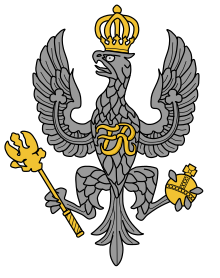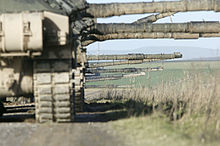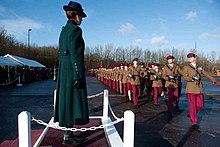| The King's Royal Hussars | |
|---|---|
 Cap badge of the King's Royal Hussars Cap badge of the King's Royal Hussars | |
| Active | 2 December 1992- |
| Allegiance | |
| Branch | |
| Type | Line cavalry |
| Role | Armoured warfare |
| Size | One regiment |
| Part of | 12th Armoured Brigade Combat Team |
| Garrison/HQ | HHQ - Winchester Regiment - Tidworth |
| March | Quick - The King's Royal Hussars Slow - Coburg Other - The Eagle |
| Commanders | |
| Colonel-in-Chief | Anne, Princess Royal |
| Colonel of the Regiment | Brig Nicholas Orr |
| Insignia | |
| Tactical Recognition Flash |  |
| Arm Badge | Crossed Kukris From 14th/20th King's Hussars |
| Abbreviation | KRH |
The King's Royal Hussars (KRH) is a Royal Armoured Corps regiment of the British Army formed in 1992. Based at Tidworth it serves as the armoured regiment of the 12th Armoured Brigade Combat Team (ABCT). Under Army 2020 Refine, it is intended to exchange its Challenger 2 tanks for Ajax vehicles.
History

The regiment was formed on 4 December 1992 by the amalgamation of two other regiments:
- The Royal Hussars (Prince of Wales's Own) (an amalgamation of the 10th Royal Hussars (Prince of Wales's Own) and 11th Hussars (Prince Albert's Own)) and
- 14th/20th King's Hussars (an amalgamation of the 14th King's Hussars and the 20th Hussars).
The regiment was based at York Barracks in Münster at the time of amalgamation from where it deployed units to Northern Ireland on Operation Banner in June 1994 and to Bosnia and Herzegovina in January 1996.
The regiment deployed units to Bosnia and Herzegovina again in June 1997 and to both Bosnia and Herzegovina and Kosovo in autumn 1999. The regiment returned to Aliwal Barracks at Tidworth Camp in March 2000 from where it deployed units to Northern Ireland in October 2002; it also deployed units to Iraq on Operation Telic 1 in June 2003, Operation Telic 6 in May 2005 and Operation Telic 10 in June 2007. The regiment also deployed on Operation Herrick 7 in September 2007 and Operation Herrick 16 in April 2012.
Organisation

The regiment currently serves in the armoured role, equipped with Challenger 2 tanks, and is based in Tidworth, Wiltshire. The regiment is organised into a total of five squadrons, each of which perpetuates the title of one of its antecedent regiments:
- A Squadron (The Twentieth Hussar Squadron)
- B Squadron (The Fourteenth Hussar Squadron)
- C Squadron (The Eleventh Hussar Squadron)
- D Squadron (The Tenth Hussar Squadron)
- HQ Squadron
C Squadron traditionally is the senior squadron of the King's Royal Hussars in perpetuation of the honour accorded to C Squadron the 11th Hussars in Egypt.
Uniform
Crimson trousers

The regiment wears crimson trousers when in full dress, No. 1 dress or No. 2 dress, and (for officers and NCOs) mess dress. They may also be worn in shirt sleeve order by officers, including those on secondment to the regiment from other units. This distinctive feature, which is unique in the British Army, derives from the honour accorded to the 11th Hussars by Prince Albert, the future consort of Queen Victoria. The regiment, then based at Canterbury, formed the escort for the Prince from his arrival at Dover en route to his wedding in London. The Prince was so impressed with the bearing and turnout of the troops that he ordered that they should henceforth wear his livery as a mark of distinction.
Brown beret
The regiment wears a unique brown beret. This practice began when the 11th Hussars were mechanized in 1928. It was found that the traditional forage cap with a peak was inconvenient when peering through an armoured vehicle gunsight, so it was decided to adopt a beret. It is believed that the brown colour was selected by the then quartermaster's wife as a practical choice for working with oily vehicles, rather than horses. The beret was originally worn without a cap badge but with a broad crimson band. On almagamation with the 10th Hussars PWO (the senior regiment of the two), who had a red patch behind their cap badge, it was agreed in discussions between representatives of both regiments (10th and 11th) to retain the patch but the colour was changed to crimson to represent the crimson band. Since 2003 the Royal Wessex Yeomanry has also worn the brown beret.
The Gurkha link

The regiment wear the crossed kukri of the Gurkhas as an arm badge. This relates back to 1945 when C Squadron, 14th/20th King's Hussars assaulted the town of Medicina in Italy alongside the 2nd Battalion, 6th Gurkha Rifles, inflicting heavy losses on the German defenders despite being outnumbered. In commemoration of this action the 14th/20th King's Hussars adopted the crossed kukri badge, a tradition maintained by the regiment.
The Emperor
During the Battle of Vitoria in June 1813, the 14th Light Dragoons captured from a French baggage train, a silver chamber pot belonging to King Joseph Bonaparte which he had received from his brother, Emperor Napoleon. The regiment gained the regimental nickname of "The Emperor's Chambermaids" and retained the chamber pot as a loving cup known as "The Emperor". The King's Royal Hussars, as the successor to the 14th Light Dragoons, still retain "The Emperor", and their officers drink from it on mess nights.
Regimental museum
"HorsePower: The Museum of the King's Royal Hussars" is the regiment's museum and forms part of Winchester's Military Museums in Winchester, Hampshire.
Colonel-in-Chief
Regimental Colonels
Colonels of the Regiment have been:
- 1992–1997: Maj-Gen. John Peter William Friedberger, CB, CBE (ex Royal Hussars)
- 1997–2002: Brig. Euan Charles Wortham Morrison, OBE
- 2002–2007: Brig. Christopher Keith Price, CBE
- 2007–2012: Colonel David Woodd
- 2012–2017: General Sir Richard Shirreff, KCB CBE
- 2017–2022: General Sir Adrian Bradshaw, KCB OBE DL
- 2022–present: Brigadier J. Nicholas N. Orr
Commanding Officers
Commanding Officers have included:
- 1992–1994: Lieutenant Colonel David J. B. Woodd
- 1994–1996: Lt Col Alexander Richard David Shirreff
- 1996–1998: Lt Col Adrian John Bradshaw
- 1998–2001: Lt Col Jonathan J. Powe
- 2001–2003: Lt Col Timothy C. Allen
- 2003–2005: Lt Col S. Toby W. Bridge
- 2005–2008: Lt Col J. Nicholas N. Orr
- 2008–2010: Lt Col Giles R. M. Harrison
- 2010–2013: Lt Col Alexander T. L. Potts
- 2013–2015: Lt Col Justin J. Kingsford
- 2015–2017: Lt Col James D. H. Porter
- 2017–2020: Lt Col Angus M. A. Tilney MC
- 2020–2022: Lt Col Will D. Hodgkinson MBE
- 2022–Present Lt Col Pete Perowne
Notable officers
- Alexander Windsor, Earl of Ulster
- Jamie Snowden
Lineage
| 1881 Childers Reforms | 1922 Amalgamations | 1966 Defence White Paper | 1990 Options for Change - today |
|---|---|---|---|
| 10th (Prince Of Wales's Own Royal) Hussars | Royal Hussars (Prince of Wales's Own) | King's Royal Hussars | |
| 11th (Prince Albert's Own) Hussars | |||
| 14th (The King's) Hussars | 14th/20th King's Hussars | ||
| 20th Hussars | |||
Alliances
 Canada - 1st Hussars
Canada - 1st Hussars Australia - 10th Light Horse
Australia - 10th Light Horse Australia - 2nd/14th Light Horse Regiment (Queensland Mounted Infantry)
Australia - 2nd/14th Light Horse Regiment (Queensland Mounted Infantry) Australia - 4th/19th Prince of Wales's Light Horse
Australia - 4th/19th Prince of Wales's Light Horse New Zealand - Queen Alexandra's Mounted Rifles
New Zealand - Queen Alexandra's Mounted Rifles Pakistan - The Guides Cavalry (Frontier Force)
Pakistan - The Guides Cavalry (Frontier Force) Zambia - Zambia Armoured Car Regiment
Zambia - Zambia Armoured Car Regiment Royal Navy - HMS Dauntless
Royal Navy - HMS Dauntless Royal Air Force - IX(B) Squadron
Royal Air Force - IX(B) Squadron  France – 5e Régiment de Dragons
France – 5e Régiment de Dragons
Affiliated Yeomanry
- The Royal Wiltshire Yeomanry (Prince of Wales's Own)
- The Royal Gloucestershire Hussars
- The Duke of Lancaster's Own Yeomanry
Order of precedence
| Preceded byThe Royal Lancers | Cavalry Order of Precedence | Succeeded byLight Dragoons |
References
- "British Army to form first strike brigade, cut MBT numbers". IHS Janes. Retrieved 18 December 2016.
- "Strategic Defence and Security Review - Army:Written statement - HCWS367 - UK Parliament". Parliament.uk. 2014-12-04. Retrieved 2016-12-16.
- "The King's Royal Hussars - History and Traditions". Ministry of Defence. Retrieved 29 July 2016.
- ^ "King's Royal Hussars". British Army units 1945 on. Retrieved 3 May 2014.
- "King's Royal Hussars return home from Afghanistan". Ministry of Defence. 22 October 2012. Retrieved 29 July 2016.
- ^ Journal of The King's Royal Hussars 1992
- "The Regiment - The King's Own Royal Hussars" Issue 9
- "Y (RWY) Squadron in 2014" (PDF). Chain Mail. p. 20. Retrieved 29 July 2016.
- "Medicina1015". Noah's Arc: The Club of the 14th/20th King's Hussars. Archived from the original on 14 November 2017. Retrieved 29 July 2016.
- "The Emperor 1813". The King's Royal Hussars. Archived from the original on 4 November 2022. Retrieved 27 August 2016.
- "The museum". Horsepower. Archived from the original on 7 June 2016. Retrieved 29 July 2016.
- "The King's Royal Hussars". regiments.org. Archived from the original on 12 January 2008. Retrieved 27 July 2017.
{{cite web}}: CS1 maint: bot: original URL status unknown (link) - "No. 63914". The London Gazette (Supplement). 28 December 2022. p. 24832.
- Regiments and Commanding Officers, 1960–.
- "No. 56055". The London Gazette (Supplement). 12 December 2000. p. 13980.
- Souster, Mark. "The former army colleagues going for gold". The Times. ISSN 0140-0460. Retrieved 2022-01-02.
External links
- Official site
- British Army Locations from 1945 British Army Locations from 1945
- The King's Royal Hussars Association The King's Royal Hussars Association
- Noahs Arc - The Club of the 14th/20th King's Hussars Noahs Arc - The Club of the 14th/20th King's Hussars
| King's Royal Hussars | |||||
|---|---|---|---|---|---|
| Predecessors |
| ||||
| Victoria Cross | |||||
| See also | |||||
| Household Cavalry and Royal Armoured Corps | |
|---|---|
| Armoured | |
| Armoured cavalry | |
| Light cavalry | |
| Public duties | |
| Training |
|
| British Army | |||||||||||||||||||||||||||||||
|---|---|---|---|---|---|---|---|---|---|---|---|---|---|---|---|---|---|---|---|---|---|---|---|---|---|---|---|---|---|---|---|
| General (lists) |
| ||||||||||||||||||||||||||||||
| Regiments and corps |
| ||||||||||||||||||||||||||||||